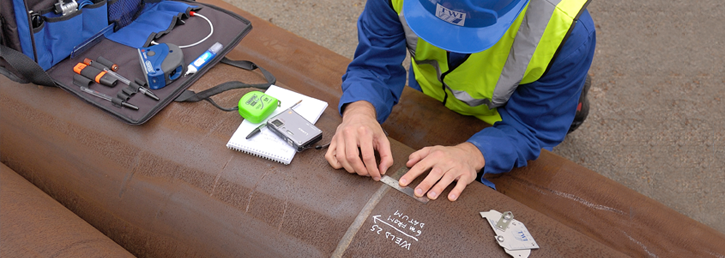Exploring Advanced Equipment and Approaches for Accurate Welding Evaluation
In the world of welding examination, the pursuit of precision and integrity is extremely important, stimulating the growth of innovative tools and approaches. Laser scanning advancements and automatic assessment systems, geared up with synthetic knowledge, are redefining the landscape by minimizing human error and enhancing safety and security steps.
Ultrasonic Checking Developments
Ultrasonic screening developments regularly stand for the forefront of improvements in welding examination innovations. These technologies have considerably improved the capacity to detect and examine discontinuities within welded structures, making certain improved stability and security.

Additionally, improvements in software algorithms for information evaluation have enhanced the precision of issue detection and sizing. Automated ultrasonic testing systems currently supply high-resolution imaging, enabling in-depth assessments of weld quality. These systems are commonly incorporated with advanced visualization tools, which help with the interpretation of outcomes.
Radiographic Examination Techniques
While ultrasonic testing developments have set a high requirement in non-destructive exam, radiographic examination techniques continue to play an essential function in welding assessment by using unique understandings right into material honesty. Radiographic screening (RT) uses the usage of X-rays or gamma rays to pass through products, producing a radiograph that aesthetically represents the interior structure of a weld. This imaging capability is indispensable for finding subsurface issues such as porosity, incorporations, and splits that might not be visible through surface inspections.
The procedure entails putting a radiation source on one side of the weld and a detector on the contrary side. Variants in material density and thickness affect the attenuation of the rays, generating a different picture that precisely marks imperfections. RT is especially beneficial for inspecting intricate geometries and thick sections where various other approaches may drop brief.
In spite of its effectiveness, radiographic inspection must be performed with rigorous adherence to safety procedures due to the unsafe nature of ionizing radiation. In addition, the interpretation of radiographs calls for knowledgeable workers, as the quality of the evaluation directly affects the reliability of the examination. Consequently, continuous innovations in digital radiography are boosting image clearness and analysis performance, strengthening RT's essential function in making certain weld quality.
Laser Scanning Advances
Accepting laser scanning modern technology in welding inspection has reinvented the analysis of weld top quality and honesty. This innovative method offers a non-contact, high-resolution means of capturing comprehensive 3D information of weld surface areas. Unlike typical inspection techniques, laser scanning offers rapid data acquisition, considerably enhancing the efficiency and accuracy of weld evaluations. The innovation uses laser beams to create accurate 3D designs, which are crucial for in-depth analysis of weld dimensions, surface irregularities, and prospective problems.
Laser scanning developments have caused considerable enhancements in defining and discovering surface defects such as porosity, lack of combination, and undercuts. The high-resolution data allows assessors to do thorough analyses, guaranteeing that welds meet stringent sector criteria. Moreover, this technique supports the growth of digital records, promoting lasting quality control and traceability.
Furthermore, laser scanning technology incorporates perfectly with software options developed for automated defect you could try this out discovery and assessment. The resultant information can be easily shared and assessed, promoting joint decision-making processes. As sectors remain to require higher requirements for weld quality, laser scanning remains at the center, providing unrivaled accuracy and efficiency in welding assessment.
Automated Inspection Solutions

Automated examination systems supply the advantage of consistency, removing human error and subjectivity from the inspection procedure. They are created to operate in various settings, from production floors to remote field websites, ensuring detailed coverage. Welding Inspection Madison. These systems can be set to stick to particular welding standards and requirements, offering thorough reports and documentation for quality assurance purposes
In addition, the combination of cloud-based systems assists in the storage and evaluation of substantial quantities of inspection information. This enables pattern analysis and predictive upkeep, allowing makers to deal with possible concerns before they intensify. The fostering of automatic examination systems is a critical step towards improving the integrity and efficiency of welding processes in commercial applications.

Enhancing Safety and Effectiveness
A considerable facet of boosting safety click here to find out more and security and efficiency in welding evaluation lies in the combination of ingenious innovations that simplify procedures and minimize threats. The fostering of innovative non-destructive screening (NDT) techniques, such as ultrasonic screening, phased selection ultrasonic screening (PAUT), and radiographic screening, plays a pivotal function in making sure architectural stability without compromising the safety of the personnel entailed. These strategies enable for detailed evaluations with minimal downtime, reducing possible dangers connected with conventional methods.
In addition, the execution of real-time data analytics and artificial intelligence formulas has changed the method inspection information is translated. By employing anticipating analytics, potential issues can be determined before they show up into crucial failings, making sure timely treatments and maintenance. This aggressive strategy dramatically improves operational effectiveness and safety in welding procedures.
Additionally, remote inspection innovations, consisting of drones and robot spiders equipped with high-resolution cams, make it possible for inspectors to evaluate hard-to-reach locations without revealing them to hazardous conditions. This not only enhances examination accuracy but also lessens human threat. By leveraging these advanced tools and methods, industries can accomplish higher security requirements and functional effectiveness, eventually bring about more lasting and reliable welding inspection techniques.
Conclusion
The combination of sophisticated devices and techniques in welding assessment dramatically enhances defect detection and ensures architectural honesty. Welding Inspection Madison. Technologies such as phased selection ultrasonic screening, electronic radiography, and laser scanning boost flaw characterization, while automated assessment systems and AI click here for more minimize human error. Remote innovations help with safe assessments in unsafe settings, advertising a positive maintenance approach. These advancements not only raise examination performance yet likewise add to enhanced safety and security and top quality guarantee in industrial welding applications.

Ultrasonic screening developments regularly represent the leading edge of advancements in welding assessment technologies.While ultrasonic testing technologies have set a high criterion in non-destructive examination, radiographic assessment methods continue to play an indispensable role in welding assessment by offering distinct understandings right into material integrity.Accepting laser scanning modern technology in welding inspection has reinvented the analysis of weld top quality and integrity. As markets proceed to require greater standards for weld high quality, laser scanning stays at the center, supplying unrivaled precision and effectiveness in welding assessment.
Automated examination systems offer the advantage of consistency, eliminating human error and subjectivity from the evaluation process.